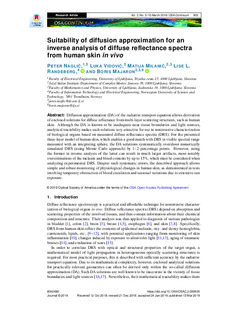| dc.contributor.author | Naglic, Peter | |
| dc.contributor.author | Vidovic, Luka | |
| dc.contributor.author | Milanic, Matija | |
| dc.contributor.author | Randeberg, Lise Lyngsnes | |
| dc.contributor.author | Majaron, Boris | |
| dc.date.accessioned | 2020-01-13T09:06:27Z | |
| dc.date.available | 2020-01-13T09:06:27Z | |
| dc.date.created | 2020-01-11T10:52:30Z | |
| dc.date.issued | 2019 | |
| dc.identifier.citation | OSA Continuum. 2019, 2 (3), . | nb_NO |
| dc.identifier.issn | 2578-7519 | |
| dc.identifier.uri | http://hdl.handle.net/11250/2635856 | |
| dc.description.abstract | Diffusion approximation (DA) of the radiative transport equation allows derivation of enclosed solutions for diffuse reflectance from multi-layer scattering structures, such as human skin. Although the DA is known to be inadequate near tissue boundaries and light sources, analytical tractability makes such solutions very attractive for use in noninvasive characterization of biological organs based on measured diffuse reflectance spectra (DRS). For the presented three-layer model of human skin, which enables a good match with DRS in visible spectral range measured with an integrating sphere, the DA solutions systematically overshoot numerically simulated DRS (using Monte Carlo approach) by 1–2 percentage points. However, using the former in inverse analysis of the latter can result in much larger artifacts, most notably overestimations of the melanin and blood contents by up to 15%, which must be considered when analyzing experimental DRS. Despite such systematic errors, the described approach allows simple and robust monitoring of physiological changes in human skin, as demonstrated in tests involving temporary obstruction of blood circulation and seasonal variations due to extensive sun exposure. | nb_NO |
| dc.language.iso | eng | nb_NO |
| dc.publisher | OSA Publishing | nb_NO |
| dc.rights | Attribution-NonCommercial-NoDerivatives 4.0 Internasjonal | * |
| dc.rights.uri | http://creativecommons.org/licenses/by-nc-nd/4.0/deed.no | * |
| dc.title | Suitability of diffusion approximation for an inverse analysis of diffuse reflectance spectra from human skin in vivo | nb_NO |
| dc.type | Journal article | nb_NO |
| dc.type | Peer reviewed | nb_NO |
| dc.description.version | publishedVersion | nb_NO |
| dc.source.pagenumber | 18 | nb_NO |
| dc.source.volume | 2 | nb_NO |
| dc.source.journal | OSA Continuum | nb_NO |
| dc.source.issue | 3 | nb_NO |
| dc.identifier.doi | 10.1364/OSAC.2.000905 | |
| dc.identifier.cristin | 1770647 | |
| dc.description.localcode | © 2019 Optical Society of America under the terms of the OSA Open Access Publishing Agreement | nb_NO |
| cristin.unitcode | 194,63,35,0 | |
| cristin.unitname | Institutt for elektroniske systemer | |
| cristin.ispublished | true | |
| cristin.fulltext | original | |

